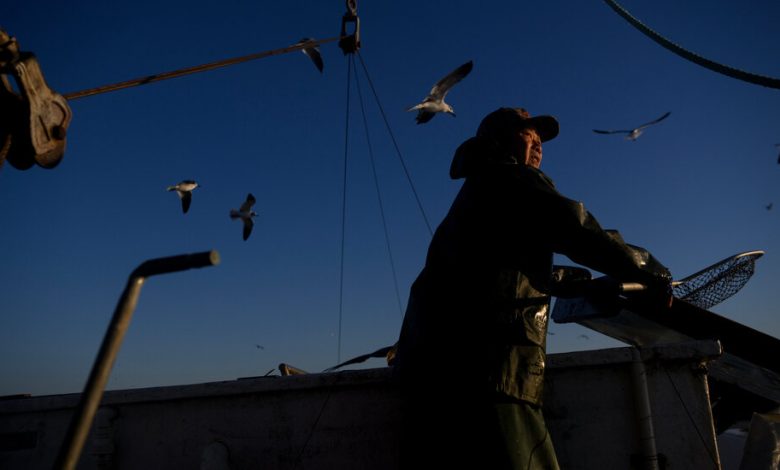In Texas, Vietnamese American Shrimpers Must Forge a New Path Again

ACROSS THE COUNTRY

In Texas, Vietnamese American Shrimpers Must Forge a New Path Again
They overcame the trauma of war, language barriers and prejudice to become successful shrimpers. But the decline of the industry in America is forcing them to consider other options.
WHY WE’RE HERE
We’re exploring how America defines itself one place at a time. Palacios, Texas, is a small town with a rich history of Vietnamese American shrimpers on the Gulf Coast.


By Amy Qin
Photographs by Callaghan O’Hare
Amy Qin and Callaghan O’Hare reported from a shrimp trawler in Palacios, Texas.
Nov. 12, 2023
The sun was still rising when Vinh Nguyen hauled in his first catch of the day.
For the next half-hour, he worked methodically, using his bare fingers to sort the slippery crustaceans from Matagorda Bay. The famed Texas brown shrimp went in one bucket. The Texas white shrimp in another. Seagulls and pelicans hovered around him in the cool, sticky air, while dolphins swam alongside the boat. All were eager for the discarded fish — free breakfast.
By noon, Mr. Nguyen caught enough shrimp to take home about $600, a decent profit these days, but still less than in years past when $1,000 marked a good day.
“Not much,” he frowned, as he stood on the slick deck assessing the ice chests that were now filled with shrimp.
Mr. Nguyen, 63, is one of thousands of Vietnamese refugees who settled along the Gulf Coast after the Vietnam War. Here, in quiet fishing communities, they worked hard to rebuild their lives. Along the way, they overcame the trauma of war and displacement, language barriers and deep-seated prejudice from local residents.
But their latest obstacle is beyond their control: the decline of the American shrimp industry.
Across the Gulf Coast, high fuel costs, a shortage of workers and an influx of cheap imports have made shrimping a less viable proposition for anyone.
Some locals say that overfishing and environmental factors like climate change have also led to a decline in the seafood population, making it even harder to get a decent haul.
“A lot of the Vietnamese shrimpers have cried to me,” said Thuy Vu, 57, who fled war-torn Vietnam as a child. She is now the business manager of her family’s shrimping operation in Palacios, Texas, one of the small communities where Vietnamese immigrants settled.
Ms. Vu said that the first generation of fishermen who arrived decades ago had dreamed of selling their boats and businesses to younger crews. “But now that doesn’t look very likely,” she lamented.
After a visit to Palacios (pronounced puh-LASH-es) last month, it was not hard to imagine what the town looked like when the first group of about 100 Vietnamese refugees arrived in 1976.
Located about halfway between Houston and Corpus Christi, the town sits on verdant ranch land that unfurls into a sparkling bay. The population remains about the same, 4,400, and the downtown still has just one traffic light. It is a far cry from the sprawling hubs like Houston and Orange County, Calif., that often form the backdrop to Vietnamese stories in America.
Vietnamese refugees were initially drawn to Palacios by the promise of jobs at a nearby nuclear power plant and a crab processing factory. But they soon turned their attention to the local shrimping and crabbing industries.
Out on the water, no English was required. And many of them already had the right skills. Back in Vung Tau, a coastal town in southern Vietnam, some had worked as fishermen and net makers.
It wasn’t long, though, before the local shrimpers and crabbers felt threatened. The newcomers didn’t abide by the rules of the water, the locals grumbled. When Vietnamese immigrants paid cash for their boats by pooling their savings, the locals accused them of getting special government loans.
Tensions peaked in 1979 in the town of Seadrift, 45 miles down the coast from Palacios, when a Vietnamese fisherman shot and killed a white crabber who had been harassing him over fishing territory. A jury acquitted the fisherman after he argued that the shooting was in self-defense.
The incident, which was the subject of a recent documentary, ignited a furor among the white fishermen, who bombed three boats owned by Vietnamese immigrants in response.
“We couldn’t go anywhere, we stayed inside, we were so scared,” recalled The Nguyen, 66, a crabber in Seadrift. “And then we took our boats and ran for it.”
The small-town dispute soon escalated into a broader campaign in which members of the Ku Klux Klan set fire to several boats near Galveston Bay and burned crosses near the homes of Vietnamese fishermen. Tensions only abated after the Southern Poverty Law Center, together with the Vietnamese Fishermen’s Association, filed a federal lawsuit to stop the Klan’s intimidation tactics.
Some Vietnamese immigrants who had fled eventually returned to Seadrift and nearby towns. The allure of the shrimping and crabbing life was too strong.
“If you push people into a corner, they will fight back,” said T.V. Tran, 75, one of the first Vietnamese people to come to Palacios.
Over time, relations improved. The fishermen who immigrated from Vietnam adapted to local rules that were intended to sustain the shrimp population, like not dragging their nets before sunrise. They began to earn the respect of the white and Latino fishermen.
“They built their own boats and paid for everything with their own money,” said David Aparicio, 67, a second-generation Mexican American shrimper in Palacios. “They didn’t do anything wrong other than work too hard.”
In the 1980s and 1990s, more Vietnamese immigrants moved to Palacios to get into the shrimping business. Many lived in mobile homes, squeezing as many as 20 people into one trailer. Some upgraded from smaller bay boats to big gulf boats, which could bring in higher profits.
As a high school student, Yen Tran woke up at 5 a.m. to pick crab meat for a dollar per pound, after which she would go home, shower and go to class. After school, she would head straight to the dock to head shrimp when it was in season, said Ms. Tran, who is not related to T.V. Tran.
“It was hard work, and it was smelly,” said Ms. Tran, 60, a retired math teacher who still lives in Palacios. “But most of the kids did it.”
Slowly, Vietnamese Americans became part of the fabric of the town. At Palacios High School, they became homecoming queens, football stars and valedictorians. Restaurants serving Vietnamese fare like pho and shrimp spring rolls began to pop up. Boats with names like “Miss Anh Dao” could be seen docked alongside “Kris and Cody.” In 2020, the town elected its first-ever Vietnamese American mayor, Linh Van Chau.
“There might have been some resistance before, but the Vietnamese are held in very high regard nowadays here, and they are a very prominent part of our town,” said Jim Gardner, the current mayor of Palacios, who described Mr. Chau as a close friend and mentor.
“And the pho,” Mr. Gardner added, “it’s some kind of good.”
Shrimp is the most consumed seafood in the United States, but the vast majority of it comes from elsewhere. In recent years, global imports have increased from countries like India and Ecuador, devastating the domestic shrimp industry. Shrimpers across the Gulf Coast have called on the federal government to curb imports.
Many Vietnamese American shrimpers have worked hard and saved enough to send their children to college and spare them from the backbreaking labor that shrimping required.
But some of them are facing their own financial uncertainty as they near retirement age. In recent years, many have found more stable work in construction or in nail salons, said Ms. Vu, the shrimping business manager.
“Maybe because we came here with nothing, we don’t dare to complain much,” Ms. Vu said. “But there’s a feeling that there’s no longer any promise left in this industry.”
Vinh Nguyen, the shrimper, isn’t giving up just yet. He said he needed to hold out for just three more years — long enough to put his youngest child, Dorothy, through college, so she could achieve her dream of becoming a doctor.
“America still has opportunities,” Mr. Nguyen said in the cabin of his trawler during a break. In the background, the voice of a fellow Vietnamese shrimper crackled over the boat’s radio system with an update. There was more shrimp to be caught in another part of the bay.
Mr. Nguyen grabbed the steering wheel. It was time to move on.



